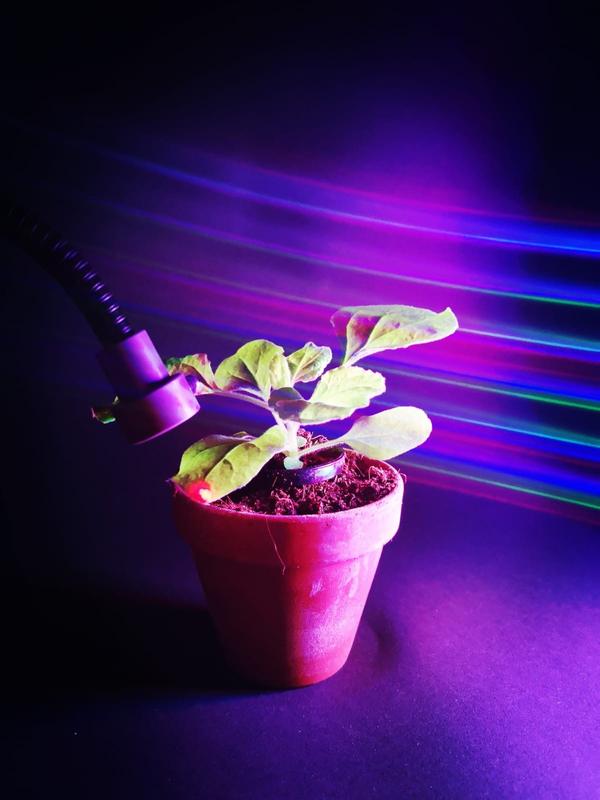Optogenetics: Controlling plant processes with light

Optogenetics in plants. PULSE enables targeted and reversible gene expression control in plants in the presence of ambient light. Leonie-Alexa Koch Institute of Synthetic Biology, University of Düsseldorf
A research team of biologists within the CEPLAS Cluster of Excellence at Heinrich Heine University Düsseldorf (HHU) has succeeded, together with colleagues from the University of Freiburg, to develop an optogenetic tool for use in plant research. As the researchers now report in NATURE METHODS, the tool can be used to control plant processes precisely using light.
Optogenetics offers a very powerful research toolset for biology. It can be used to control cellular events using light-responsive switches by activating specific sections of the genome in a targeted manner. For example, signalling and metabolic processes can be controlled through targeted activation using light.
Many optogenetic publications are focused on cells in mammalian, yeast and bacterial systems. Research from the area of plants is much less common. One of the reasons for this is a lack of suitable optical switches that can be used and switched in a targeted manner in plant cells, as the plants themselves require light to grow and the switches would therefore be constantly active.
A team working with HHU-CEPLAS-researchers Prof. Dr. Matias Zurbriggen (Institute of Synthetic Biology) and Prof. Dr. Rüdiger Simon (Institute of Developmental Genetics) has now succeeded, in cooperation with colleagues from the University of Freiburg-CIBSS and the University of East Anglia-Norwich, to develop a customised optogenetic switch for plants.
This tool, named ‘PULSE’ (Plant Usable Light-Switch Elements), is suitable for plants growing under normal day/night cycles. Targeted illumination with red light activates gene expression, while ambient white light is used to reverse the process.
To do this, PULSE has two optogenetic switches that respond to two different wavelengths. The monochromatic red light activates the switch, allowing a certain gene to be expressed at that precise moment. Blue light from daylight resets the switch, thus stopping gene expression.
This process can be repeated any number of times. Prof. Zurbriggen explained the significance of the development: “PULSE introduces the superior advantages of optogenetics into plants.
The system is fully reversible, and achieves high dynamic ranges of expression and temporal resolution. The control of cellular processes with high spatiotemporal resolution is key to quantitatively understand the dynamics of biological signalling networks and for developing biotechnological applications.”
The researchers in Düsseldorf first applied PULSE in one of biology’s model plants, thale cress (Arabidopsis thaliana). It was then possible to combine this tool with CRISPR/Cas9-based technologies. Finally, they were able to use tobacco plants (Nicotiana benthamiana) and thale cress to manipulate physiological responses in plants, for example their immune response.
Prof. Simon commented: “The optogenetic tool makes it possible to programme the expression of desired properties in a plant. We therefore think that PULSE and the conceivable expanded optogenetic toolset will facilitate in the future the targeted manipulation and study of biological processes in plants including development, growth, hormone signalling and stress responses.”
The work was carried out within the Cluster of Excellence on Plant Sciences (CEPLAS) research programme. The HHU team worked with researchers from the CIBSS – Centre for Integrative Biological Signalling Studies, Cluster of Excellence at the University of Freiburg led by Prof. Dr. Thomas Ott, Prof. Dr. Wilfried Weber and Prof. Dr. Jens Timmer and Ben Miller of the University of East Angli
Arne Claussen
Rocio Ochoa-Fernandez, Nikolaj B. Abel, Franz-Georg Wieland, Jenia Schlegel, Leonie A. Koch, J. Benjamin Miller, Raphael Engesser, Giovanni Giuriani, Simon M. Brandl, Jens Timmer, Wilfried Weber, Thomas Ott, Rüdiger Simon, Matias D. Zurbriggen, Optogenetic control of gene expression in plants in the presence of ambient white light, Nature Methods (accepted 18 May 2020, published online 29 June 2020)
Online publication: https://www.nature.com/articles/s41592-020-0868-y
DOI: 10.1038/s41592-020-0868-y
Media Contact
More Information:
http://www.hhu.de/All latest news from the category: Life Sciences and Chemistry
Articles and reports from the Life Sciences and chemistry area deal with applied and basic research into modern biology, chemistry and human medicine.
Valuable information can be found on a range of life sciences fields including bacteriology, biochemistry, bionics, bioinformatics, biophysics, biotechnology, genetics, geobotany, human biology, marine biology, microbiology, molecular biology, cellular biology, zoology, bioinorganic chemistry, microchemistry and environmental chemistry.
Newest articles

Pinpointing hydrogen isotopes in titanium hydride nanofilms
Although it is the smallest and lightest atom, hydrogen can have a big impact by infiltrating other materials and affecting their properties, such as superconductivity and metal-insulator-transitions. Now, researchers from…

A new way of entangling light and sound
For a wide variety of emerging quantum technologies, such as secure quantum communications and quantum computing, quantum entanglement is a prerequisite. Scientists at the Max-Planck-Institute for the Science of Light…

Telescope for NASA’s Roman Mission complete, delivered to Goddard
NASA’s Nancy Grace Roman Space Telescope is one giant step closer to unlocking the mysteries of the universe. The mission has now received its final major delivery: the Optical Telescope…



